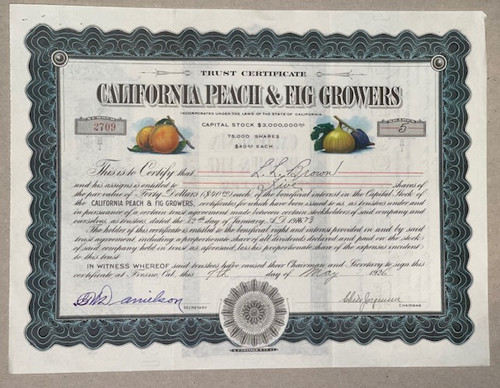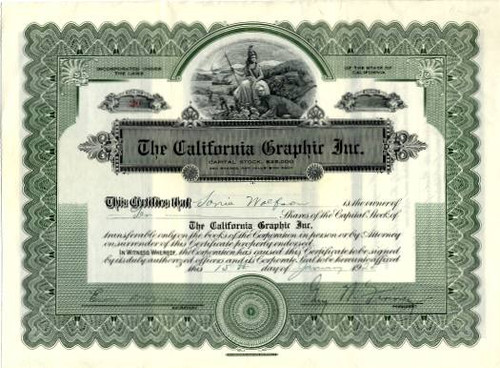Beautiful certificate from the California Prune and Apricot Growers issued in 1921. This historic document was printed by Goes Banknote Company and has an ornate border around it. This item has the signatures of the Company's Chairman, Irwin Pomeroy and Secretary and is over 87 years old. The California Prune and Apricot Growers marketed the Sunsweet Brand. This cooperative brought together small growers from around the state to maximize their presence in the market. Sunsweet traces its history back to 1917, when some California fruit growers formed a cooperative named California Prune and Apricot Growers in an effort to raise and stabilize what had been disastrously low prices for their commodities. Immediately, the cooperative began nationwide advertising and marketing under the brand name Sunsweet. Although the company lost members during the boom times of the 1920s, as general confidence in market conditions prompted a desire for independence, it regained many members during the Great Depression when companies sought safety in numbers. In 1934 the cooperative joined with fruit juice company Duffy-Mott to produce and market Sunsweet prune juice. Already smarting from the worldwide depression, California Prune and Apricot took another heavy blow in 1933 when the German government banned imported fruit. Exports to Germany had accounted for as much as half of California's annual prune sales since before World War I. The company sought to improve sales with improved packaging and high profile domestic advertising campaigns, and once the United States entered World War II, the demand for dried fruit products rose again. However, as with its future associates in the walnut industry, chronic oversupply and depressed commodity prices burdened California Prune and Apricot in the postwar period. As a response, the company increased its membership in 1959 and in 1960 changed its name to Sunsweet Growers. By the mid-1970s, both Diamond Walnut and Sunsweet had become preeminent in their respective domains. Diamond Walnut processed and marketed just over half of California's walnut crop, while Sunsweet handled about one third of the state's prune crop. Both companies felt that combined marketing would be of further benefit, and in 1974 they banded together to form Diamond/Sunsweet. The two companies did not merge assets and liabilities, but did combine their marketing operations. Diamond Walnut president and general manager A. L. Buffington became CEO of the separate cooperatives, and headquarters were established in Stockton, California. Such combinations between agricultural cooperatives were seen as necessary in a time of increasing competition from overseas, as well as from other large cooperatives in the United States, and Diamond/Sunsweet would soon show that it felt even further growth would be necessary for it to maintain its competitive edge. Seeking an alliance that would strengthen the marketing punch of its famous Sun-Maid raisins, Sun-Maid Growers of California began courting Diamond/Sunsweet. In 1980 its sales, distribution, and administrative functions were combined with those of Diamond and Sunsweet. Sun-Maid president Frank Light became president and CEO of Sun-Diamond Growers of California. Valley Fig Growers, a cooperative of California fig growers, also joined the alliance at this time. As with the Diamond/Sunsweet alliance, the member companies pooled their marketing operations but retained autonomy over their own assets and liabilities, although the agreement substantially centralized executive power by making Light CEO of all four member cooperatives, as well as of the new concern. Sun-Maid had a long history not unlike that of its new allies. It was formed in 1912 under the name California Associated Raisin Company (CARC) to pool advertising resources and attempt to bring price stability to a market that had suffered from highly variable commodity prices. CARC debuted with a spectacular marketing gimmick, sending a train pulling sixty raisin-laden freight cars to Chicago, with each car displaying a banner with the slogan, "Raisins Grown by 6,000 California Growers." In 1915 the company introduced its longtime brand name and also its trademark, a smiling young woman wearing a red bonnet and backlit by a yellow sunburst--the Sun-Maid. In 1922, CARC changed its name to Sun-Maid Growers to link itself more explicitly with its famous logo. Shortly thereafter, however, the Sun-Maid cooperative declared bankruptcy and was nearly dissolved. It recovered only to face financial disaster again during the depths of the Great Depression. After World War II, when both the federal and California governments acted to stabilize the raisin market, Sun-Maid once again became a steady and profitable organization. Despite its troubles, the Sun-Maid remained a popular trademark with consumers and perhaps the most famous logo in the dried fruit industry. Sun-Maid's alliance with Diamond/Sunsweet and Valley Fig Growers produced a company with nearly $500 million in annual sales, and revenues grew sharply in the years immediately following the formation of Sun-Diamond despite a national recession and general crop oversupply. The new company owed much of its success to energetic marketing; under Frank Light's direction, Sun-Diamond significantly increased its annual advertising budget to $14 million. It also put considerable emphasis on developing new products, such as raisin bread and English muffins sold under the Sun-Maid name, and new applications for waste parts, such as distilling substandard raisins and prune pits into alcohol or selling them as cattle feed. Sun-Diamond continued to expand, adding a relatively small cooperative, Hazlenut Growers of Oregon, to its ranks in 1984. It had also become a Fortune 500 company early in the decade. At the same time, however, sales began to slow, from $522 million in 1983 to $487 million in 1985, and low commodity prices continued to plague the company. The company also fell victim to international trade battles, as protective and retaliatory tariffs imposed by the European community cut into its export business. Adding to these difficulties, Sun-Diamond found itself in a financial dilemma in 1985, when internal audits discovered a series of accounting errors worth $43 million. In August of that year an accounting review found that Diamond Walnut had overreported its profits for fiscal 1985 by $4.7 million, distributing more money to its member growers than it should have. Further review revealed that an inventory of unfinished walnuts sitting in Diamond Walnut's storage sheds had been overvalued by $11 million. Finally, in November, Sun-Maid discovered that it had overreported its pool proceeds by $27.3 million and had paid its members accordingly. The loss of members' equity that followed these errors and their discovery hit Sun-Maid particularly hard. The venerable raisin cooperative suffered a mass defection, as 29 percent of its member growers chose not to renew their membership contracts after the financial disclosures. These growers accounted for about one-third of Sun-Maid's crop, forcing the company to buy processed raisins from independent growers to make up for the shortfall. Diamond Walnut suffered far less--only 50 of its 2,700 growers defected--in part because fewer of its members had their contracts up for renewal, but also because daunting conditions in the walnut market made it risky to abandon the economies of scale that a large cooperative offered. Frank Light's tenure ended late in 1985 and the company entered a period of restructuring as the cooperatives evaluated their needs and considered revised designs for the agency agreement that defined their relationship. By 1987 the process was complete and a leaner, stronger Sun-Diamond emerged. This is the Sun-Diamond that exists today under the leadership of its president, Larry Busboom, as a service organization rather than a management organization. Greater autonomy was returned to the cooperatives, and each now has its own marketing team. Sun-Diamond provides a consolidated sales and distribution network for the cooperatives' consumer product line, and has earned a position of prominence in the agricultural commodity field. It showed healthy sales growth in the early 1990s, topping $600 million in both 1991 and 1992. In addition, the efficacy of the concept behind Sun-Diamond has been proven. The collective safety and the economies of scale that it creates seem essential in an industry in which variable commodity prices, competition from overseas and large domestic concerns, and the vagaries of international trade can all have considerable impact on one's ability to do business. Perhaps even more important, the impact of consolidated representation for the leading brands in the business has become a powerful tool for success in today's marketplace. Principal Subsidiaries: Diamond Walnut Growers; Hazlenut Growers of Oregon; Sun-Maid Growers of California; Sunsweet Growers; Valley Fig Growers. Source: International Directory of Company Histories, Vol. 7. St. James Press, 1993. History from Wikipedia and OldCompanyResearch.com (old stock certificate research service).
California Prune and Apricot Growers, Inc. - California 1921
MSRP:
$169.95
$139.95
(You save
$30.00
)
- SKU:
- newitem119050740
- Gift wrapping:
- Options available








